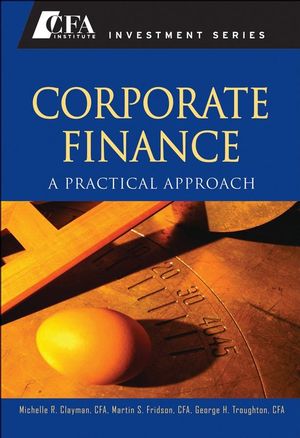|
Textbook
Corporate Finance: A Practical ApproachISBN: 978-0-470-19768-4
Hardcover
480 pages
May 2008, ©2008
 This title is out-of-print and not currently available for purchase from this site.
|
Acknowledgments.
Introduction.
Parentage.
Benefits.
Conventional Wisdom.
The Texts.
Chapter 1. Corporate Governance.
1. Introduction.
2. Corporate Governance: Objectives And Guiding Principles.
3. Forms Of Business And Conflicts Of Interest.
3.1 Sole Proprietorships.
3.2 Partnerships.
3.3 Corporations.
4. Specific Sources Of Conflict: Agency Relationships.
4.1 Manager-Shareholder Conflicts.
4.2 Director–Shareholder Conflicts.
5. Corporate Governance Evaluation.
5.1 The Board of Directors.
5.2 Examples of Codes of Corporate Governance.
6. Environmental, Social, And Governance.
7. Valuation Implications Of Corporate Governance.
Chapter 2. Capital Budgeting.
1. Introduction.
2. The Capital Budgeting Process.
3. Basic Principles Of Capital Budgeting.
4. Investment Decision Criteria.
4.1 Net Present Value.
4.2 Internal Rate of Return.
4.3 Payback Period.
4.4 Discounted Payback Period.
4.5 Average Accounting Rate of Return.
4.6 Profitability Index.
4.7 NPV Profile.
4.8 Ranking Conflicts between NPV and IRR.
4.9 The Multiple IRR Problem and the No IRR Problem.
4.10 Popularity and Usage of the Capital Budgeting Methods.
5. Cash Flow Projections.
5.1 Table Format with Cash Flows Collected by Year.
5.2 Table Format with Cash Flows Collected by Type
5.3 Equation Format for Organizing Cash Flows.
6. More On Cash Flow Projections.
6.1 Straight-Line and Accelerated Depreciation Methods.
6.2 Cash Flows for a Replacement Project.
6.3 Spreadsheet Modeling.
6.4 Effects of Inflation on Capital Budgeting Analysis.
7. Project Analysis And Evaluation.
7.1 Mutually Exclusive Projects with Unequal Lives.
7.2 Capital Rationing.
7.3 Risk Analysis of Capital Investments—Stand-Alone Methods.
7.4 Risk Analysis of Capital Investments—Market Risk Methods.
7.5 Real Options.
7.6 Common Capital Budgeting Pitfalls.
8. Other Income Measures And Valuation Models.
8.1 The Basic Capital Budgeting Model
8.2 Economic and Accounting Income
8.3 Economic Profit, Residual Income, and Claims Valuation
9. Summary.
Chapter 3. Cost Of Capital.
1. Introduction.
2. Cost Of Capital.
2.1 Taxes and the Cost of Capital.
2.2 Weights of the Weighted Average.
2.3 Applying the Cost of Capital to Capital Budgeting and Security Valuation.
3. Costs Of The Different Sources Of Capital.
3.1 Cost of Debt.
3.2 Cost of Preferred Stock.
3.3 Cost of Common Equity.
4. Topics In Cost Of Capital Estimation.
4.1 Estimating Beta and Determining a Project Beta.
4.2 Country Risk.
4.3 Marginal Cost of Capital Schedule.
4.4 Flotation Costs.
4.5 What Do CFOs Do?
Chapter 4. Capital Structure And Leverage.
1. Introduction.
2. Leverage.
3. Business Risk And Financial Risk.
3.1 Business Risk and Its Components.
3.2 Sales Risk.
3.3 Operating Risk.
3.4 Financial Risk.
3.5 Total Leverage.
3.6 Breakeven Rates and Expected Return.
3.7 The Risks of Creditors and Owners.
4. The Capital Structure Decision.
4.1 Proposition I without Taxes: Capital Structure Irrelevance.
4.3 Taxes, the Cost of Capital, and the Value of the Company.
4.4 Costs of Financial Distress.
4.5 Agency Costs.
4.6 Costs of Asymmetric Information.
4.7 The Optimal Capital Structure According to the Static Trade-Off Theory.
5. Practical Issues In Capital Structure Policy.
5.1 Debt Ratings.
5.2 Evaluating Capital Structure Policy.
5.3 Leverage in an International Setting.
Chapter 5. Dividends And Dividend Policy.
1. Introduction.
2. Forms Of Dividends.
2.1 Regular Dividends.
2.2 Extra (or Special) Dividends.
2.3 Liquidating Dividends.
2.4 Stock Dividends.
2.5 Stock Splits.
2.6 Share Repurchases.
2.7 Repurchase Methods.
2.8 Dividend Forms Outside the United States.
3 Dividend Payment Chronology.
3.1 Declaration Date.
3.2 Ex-dividend Date.
3.3 Holder-of-Record Date.
3.4 Payment Date.
3.5 Interval Between Key Dates in the Dividend Payment Chronology.
4. Factors Affecting Dividend Payout Policy.
4.1 Taxation of Dividends.
4.2 Flotation Costs on New Issues vs. Retaining Earnings.
4.3 Restrictions on Dividend Payments.
4.4 Clientele Effect.
4.5 Signaling Effect: The Information Content of Dividends.
4.6 Conclusion.
5. Dividend Policies.
5.1 Residual Dividend Approach.
5.2 Stable Dividend Policy.
5.3 Target Payout Ratio.
5.4 Share Repurchase.
5.5 Are Dividend Policies Changing?
6. The Dividend Controversy: Do Dividends Matter?
6.1 Dividends are Irrelevant.
6.2 Dividends Matter: Investors Prefer Dividends.
6.3 Dividends Matter: Investors are Tax Averse to Dividends.
7. Valuation Implications Of Dividends.
Chapter 6. Working Capital Management.
1. Introduction.
2. Managing And Measuring Liquidity.
2.1 Defining Liquidity Management.
2.2 Measuring Liquidity.
3. Managing The Cash Position.
3.1 Forecasting Short-Term Cash Flows.
3.2 Monitoring Cash Uses and Levels.
4. Investing Short-Term Funds.
4.1 Short-Term Investment Instruments.
4.2 Strategies.
4.3 Evaluating Short-Term Funds Management.
5. Managing Accounts Receivable.
5.1 Key Elements of the Trade Credit Granting Process.
5.2 Managing Customers' Receipts.
5.3 Evaluating Accounts Receivable Management.
6. Managing Inventory.
6.1 Approaches to Managing Levels of Inventory.
6.2 Inventory Costs.
6.3 Evaluating Inventory Management.
7. Managing Accounts Payable.
7.1 The Economics of Taking a Trade Discount.
7.2 Managing Cash Disbursements.
7.3 Evaluating Accounts Payable Management.
8. Managing Short-Term Financing.
8.1 Sources of Short-Term Financing.
8.2 Short-Term Borrowing Approaches.
8.3 Asset-Based Loans.
8.4 Computing the Costs of Borrowing.
Chapter 7. Financial Statement Analysis.
1. Introduction.
2. Common-Size Analysis.
2.1 Vertical Common-Size Analysis.
2.2 Horizontal Common-Size Analysis.
3. Financial Ratio Analysis.
3.1 Activity Ratios.
3.2 Liquidity Analysis.
3.3 Solvency Analysis.
3.4 Profitability Analysis.
3.5 Other Ratios.
3.6 Effective Use of Ratio Analysis.
4. Pro Forma Analysis.
4.1 Estimating the Sales-Driven Relations.
4.2 Estimating the Fixed Burdens.
4.3 Forecasting Revenues
4.4 Constructing Pro Forma Statements
Chapter 8. Mergers And Acquisitions.
1. Introduction.
2. Mergers And Acquisitions: Definitions And Classifications.
3. Motives For Merger.
3.1 Synergy.
3.2 Growth.
3.3 Increasing Market Power.
3.4 Acquiring Unique Capabilities and Resources
3.5 Diversification
3.6 Bootstrapping Earnings
3.7 Managers' Personal Incentives.
3.8 Tax Considerations.
3.9 Unlocking Hidden Value
3.10 Cross-Border Motivations
4. Transaction Characteristics.
4.1 Form of Acquisition.
4.2 Method of Payment.
4.3 Mind-Set of Target Management.
5. Takeovers.
5.1 Pre-Offer Takeover Defense Mechanisms.
5.2 Post-Offer Takeover Defense Mechanisms.
6. Regulation.
6.1 Antitrust.
6.2 Securities Laws.
7. Merger Analysis.
7.1 Target Company Valuation.
7.2 Bid Evaluation.
8. Who Benefits From Mergers?
9. Corporate Restructuring.
Glossary.
References.
About the Author(s).
Index.



